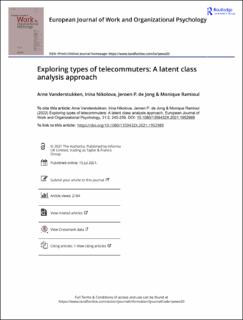| dc.contributor.author | Vanderstukken, Arne | |
| dc.contributor.author | Nikolova, Irina | |
| dc.contributor.author | De Jong, Jeroen | |
| dc.contributor.author | Ramioul, Monique | |
| dc.date.accessioned | 2023-01-18T10:08:26Z | |
| dc.date.available | 2023-01-18T10:08:26Z | |
| dc.date.created | 2021-07-05T13:06:02Z | |
| dc.date.issued | 2021 | |
| dc.identifier.citation | European Journal of Work and Organizational Psychology. 2021, . | en_US |
| dc.identifier.issn | 1359-432X | |
| dc.identifier.uri | https://hdl.handle.net/11250/3044225 | |
| dc.description.abstract | Despite initial evidence on employees’ motives for telecommuting, studies so far never investigated if and how distinct telecommuting motives might co-occur. In the current study (N wave 1 = 1297 employees; N wave 2 = 564 employees), we use Latent Class Analysis and identify three classes reflecting three specific combinations of telecommuting motives: the job requirement class (telecommuting because one has to), the efficiency class (telecommuting to cope with deadlines and pressure) and the work-life balance class (telecommuting to have a healthy balance between work and family/leisure). Our analyses show that employees belonging to the same class also tend to share a certain context (in terms of job characteristics such as speed of work and autonomy). Furthermore, the telecommuting motive classes predicted outcomes six months later: Whereas we found no significant associations between the job requirement class and the study outcomes, employees in the efficiency class reported more vigour and less emotional exhaustion, and employees in the work-life balance class reported more vigour, less emotional exhaustion and more job satisfaction. Implications for theory and practice are discussed. | en_US |
| dc.language.iso | eng | en_US |
| dc.publisher | Taylor & Francis | en_US |
| dc.rights | Attribution-NonCommercial-NoDerivatives 4.0 Internasjonal | * |
| dc.rights.uri | http://creativecommons.org/licenses/by-nc-nd/4.0/deed.no | * |
| dc.subject | Telecommuting | en_US |
| dc.subject | motives | en_US |
| dc.subject | latent classes | en_US |
| dc.subject | wellbeing | en_US |
| dc.title | Exploring types of telecommuters: A latent class analysis approach | en_US |
| dc.type | Peer reviewed | en_US |
| dc.type | Journal article | en_US |
| dc.description.version | publishedVersion | en_US |
| dc.source.pagenumber | 15 | en_US |
| dc.source.volume | 31 | en_US |
| dc.source.journal | European Journal of Work and Organizational Psychology | en_US |
| dc.source.issue | 2 | en_US |
| dc.identifier.doi | 10.1080/1359432X.2021.1952989 | |
| dc.identifier.cristin | 1920302 | |
| cristin.ispublished | true | |
| cristin.fulltext | original | |
| cristin.qualitycode | 1 | |

